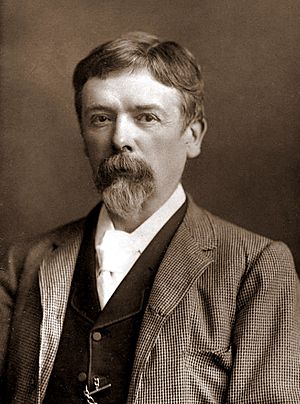George du Maurier facts for kids
Quick facts for kids
George du Maurier
|
|
|---|---|
 |
|
| Born | George Louis Palmella Busson du Maurier 6 March 1834 Paris, France |
| Died | 8 October 1896 (aged 62) Hampstead, England |
| Occupation | Cartoonist, illustrator, novelist |
| Spouse |
Emma Wightwick
(m. 1863) |
| Children | 5, including Guy, Sylvia, and Gerald |

Cartoon by du Maurier from Punch
George Louis Palmella Busson du Maurier (born March 6, 1834 – died October 8, 1896) was a British writer and cartoonist. He was famous for his drawings in Punch magazine. He also wrote a spooky novel called Trilby, which featured the character Svengali.
His son, Gerald, became a famous actor. George also had famous granddaughters, including the writers Angela du Maurier and Daphne du Maurier. He was the father of Sylvia Llewelyn Davies, whose five sons inspired J. M. Barrie to write Peter Pan!
Contents
George du Maurier's Early Life
George du Maurier was born in Paris, France. His parents were Louis-Mathurin Busson du Maurier and Ellen Clarke. His family had an interesting story about their past.
George was told that his grandparents were from a noble family. They supposedly left France during the French Revolution and moved to England. However, this wasn't quite true. His grandfather, Robert-Mathurin Busson, was actually a tradesman. He left Paris in 1789 and later changed the family name to sound more important.
George studied art in Paris and then in Antwerp, Belgium. While in Antwerp, he sadly lost the sight in his left eye. He later visited a doctor in Düsseldorf, Germany, to try and help his eye.
He met Emma Wightwick in 1853 and they married ten years later in 1863. They moved several times but settled in Hampstead, England, in 1869. They had five children: Beatrix, Guy, Sylvia, Marie Louise, and Gerald.
George du Maurier's Career
Becoming a Cartoonist
In 1865, George du Maurier started working for Punch, a popular British magazine. He drew two cartoons every week. He often made fun of the fancy ways of Victorian society. He especially liked to poke fun at the growing middle class in Britain.
One of his most famous cartoons was True Humility (1895). This cartoon helped make the phrases "good in parts" and "a curate's egg" popular. In the cartoon, a bishop tells a humble church helper, "I'm afraid you've got a bad egg, Mr. Jones." The helper replies, "Oh no, my Lord, I assure you – parts of it are excellent!"
In an earlier cartoon from 1884, du Maurier created the phrase "bedside manner". This phrase describes how doctors act with their patients. Another cool cartoon he drew in 1879 showed a made-up video phone conversation. He called this device "Edison's telephonoscope".
Besides his work for Punch, du Maurier also drew pictures for other popular magazines. These included Harper's, The Graphic, and The Cornhill Magazine. He also illustrated a book called The Notting Hill Mystery, which many people think was one of the first detective novels in English.
Becoming a Writer
As his eyesight got worse, du Maurier drew less for Punch starting in 1891. He moved to Hampstead and began writing novels.
His first novel, Peter Ibbetson (1891), was somewhat successful. It was later turned into a play and a movie.
His second novel, Trilby, came out in 1894. It was a very popular gothic horror story. The book is about a poor artist's model named Trilby O'Ferrall. She becomes a famous singer under the magical control of an evil music genius named Svengali. This book was so popular that many things were named after it, like a type of soft hat called a "trilby." The story also inspired Phantom of the Opera and many other works. George du Maurier eventually got tired of how much attention Trilby received.
His third novel was a long story called The Martian. It was published after he died in 1898 and was largely about his own life.
Death and Legacy
George du Maurier passed away on October 8, 1896. He was buried in the St John-at-Hampstead churchyard in Hampstead. Because of his successful writing and illustrations, he left a large amount of money in his will.
Du Maurier was good friends with the famous novelist Henry James. Their friendship was even written about in a book called Author, Author (2004) by David Lodge.
Film Adaptations of George du Maurier's Work
Many of George du Maurier's stories have been made into movies:
- Trilby (1914)
- Trilby (1915)
- Forever (1921)
- Trilby (1923)
- Svengali (1927)
- Svengali (1931)
- Peter Ibbetson (1935)
- The Guilt of Janet Ames (1947)
- Svengali (1954)
- Svengali (1983)
See also
- Trilbymania
Images for kids
-
"A Legend of Camelot"
Illustration by du Maurier for Punch, 17 March 1866, making fun of Pre-Raphaelitism





